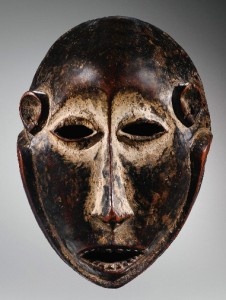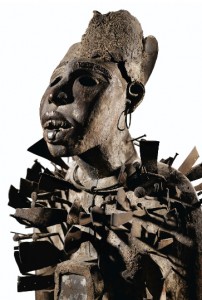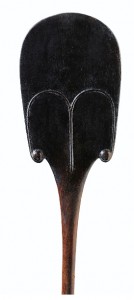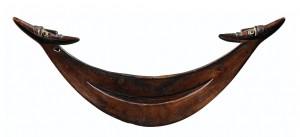Author Archives: hans
10 juni 2015: Aboriginal art, including selected works from the Thomas Vroom collection. Sotheby’s London
| | London. results
Overview
We are delighted to present Sotheby’s first London sale in the field of Aboriginal Art, showcasing artworks spanning more than 200 years by Indigenous Australians. This landmark auction is the first to be held by a major auction house outside of Australia and is centred around selected works from the Thomas Vroom Collection, one of Europe’s largest, most valuable and significant collections.
On long-term loan as the cornerstone of the AAMU, Museum of Contemporary Aboriginal Art in Utrecht, the Thomas Vroom Collection includes within it important items from the anthropological collections of Lance Bennett, Kim Akerman and Dr. Joeph Birdsell, and includes early artefacts, figurative carvings, many rare erotic bark paintings and major contemporary canvases by celebrated artists including Rover Thomas and Emily Kngwarreye.
2 – 5 juni: Kunst- en Antiekveiling, Vendu Notarishuis, Rotterdam
De kijkdagen worden gehouden op 29,30 en 31 mei van 10.00 tot 17.00 uur.
Er zullen meer dan 1600 kavels onder de hamer komen. Meubels, schilderijen, verzamelobjecten, sieraden en nog veel meer. Deze veiling een bijzondere collectie tekeningen en grafiek van Samuel Jessurun de Mesquita.
De veiling zal worden gehouden van 2-5 juni met zittingen om 10.30 en 14.00.
De nummers 1500-1558 betreffen Indonesische kunst en kunstnijverheid.
Vendu Notarishuis
Kipstraat 54
3011 RT Rotterdam
Tel: (010) 411 85 44
15 mei 2015: African, Oceanic & Pre-Columbian Art. Sotheby’s New York
| African, Oceanic & Pre-Columbian Art |
| Following a record-breaking year in 2014, Sotheby’s will present a variety of top-quality examples of African, Oceanic, and Pre-Columbian Art at our May 15 auction in New York. The sale will be led by a Congolese masterpiece of extraordinary power and refinement, the Luba Male Ancestor Statue by the Master of Warua. Other highlights will include the iconic Fang Ngil Mask previously in the collection of Prince Sadruddin Aga Khan; the famous Jernander Lwena Mask; and a highly cubistic Congolese Mask from the Kasai Region. The sale will also feature a strong selection of Pre-Columbian art from Central and South America. |
African Art – Research. Publications. Exhibitions. Auctions. Discoveries. Opinions. Objects.: Auction review by Bruno Claessens
So, how did the sale do ? Just for the African lots (lots 95-189), the total result (inclusive of buyers premium) was $9,139,125 against a total estimate for this section of $6,188,500 – 9,888,500, in other words just a bit under the high estimate. The sale total was $3 million higher, $12,144,375 (including premium) – the African half of the auction thus performed much better than the Pre-Columbian art. The 13 Oceanic lots were dominated by the monumental Bismarck head, which was sold for $ 1 million.
From the 95 African lots, 67 sold and 28 were passed (29,5 %). The African part of the sale sold 70,5 % by lot and 90 % by value. Including the buyer’s premium, 25 of the 67 objects sold above the high estimate (37 %), 36 (54 %) at or between estimates and 6 lots (9 %) under the low estimate. Note that if you deduct the buyer’s premium, 30 lots (or 45 %) sold below the low estimate (!); once again suggesting that the estimates in many cases were just too high.
Star of the sale was the cover lot, the Luba figure from the Warua Master. As seen above it was presented in a separated “black cube” (opposed to the white cubes ubiquitous in the contemporary art world?) under a very strong light – which unfortunately attracted a lot of attention to the huge amount of dust accumulated in its sticky surface (a restorer surely will have to spend an extended period of time with it!). Bidding started at $ 1,5 million (half of the low estimate). There was one bidder in the room and two others on the telephone; the first got it: the statue was hammered down at $ 3 million – $ 3,610,000 adding the buyer’s premium, becoming the most expensive Luba figure ever sold at auction. The previous holder of that record was the Luba statue from the Alan Mann collection, sold by Christie’s in December 2008 (lot 328) for $ 703K. Notwithstanding this remarkable result, selling at the low estimate (without premium), it is clear that Sotheby’s had expected of course a bit more from this statue. The interest limited to 3 collectors, the number of interested parties ideally would have been higher. In my view, the high estimate certainly played a role, but that in turn might have been necessary to persuade the consignor to let Sotheby’s sell the object. Remarkable was the fact that the statue itself was absent at the cocktail party Sotheby’s had organized the evening before the sale. It had moved to another floor for a private viewing. I thought that was a shame, but I can understand Sotheby’s had to accommodate the wishes of an interested party.
Back to the auction, the first African lot, an a-typical Kota reliquary (lot 95), did surprisingly well selling for almost double its high estimate at $ 47,5K. The next lot, a Vuvi mask was snapped up by a dealer at $ 32,5K, just above the low estimate. The “Dali”- Kota attracted only a single bid (notwithstanding its four pages in the catalogue) and sold for €100K. The next reliquary (lot 98) sold within its estimate for $ 27,5K; while a last, extremely shiny, example (lot 99) was bought by a NY dealer for $ 81,5K. Predicting the results of these Kota figures is an art form in itself. The next lot, the “Prince Saddrudin Aga Khan Fang ngil mask” (info) performed very well, more than tripling the low estimate at $ 970K. Funny detail, for the preview the beard was detached. The Fang figure in its turn failed to sell, notwithstanding the description by Louis Perrois. Petite histoire: the famous Billy Jamieson originally discovered this statue in a small sale in Toronto.
The next big lot, the Kasai helmet mask (lot 111), sold for $ 490K to a telephone bidder. It’s origin is still heavily discussed, during the preview nobody came forward with a definitive attribution – for me it is a Biombo mask (yours truly is even cited in the catalogue). Anyhow, I must say this mask looked even better in reality: it is something special – without wishing to comment on its value – which, as always, is in the eye of the beholder. Somebody did a good deal with lot 113: selling for $ 20K, this Kuba drum was sold a couple of months ago for peanuts at a small US auction – I had passed on it since I didn’t fancy the idea of paying the shipping costs, my mistake. The Lwena mask, estimated $ 300-500K, did not sell – although the final bid ($ 280K) would already have been a record price for such a mask. The Chokwe bird mask (lot 115) sold for $ 75K, just above the low estimate. It had already been unsuccessfully offered by Sotheby’s last year, at a much higher estimate.
From the Segy collection, a small Fang figure from a known hand, estimated $ 12-18K, sold for $ 75K. A Belgian dealer bought the Yombe maternity figure (lot 133) for $ 30K. A nice pair of Dogon dogs should have done better and sold within the estimate for $ 21,250. The fragmentary Mossi mask (lot 152) failed to sell (estimated $ 60-90K). That rarity alone isn’t sufficient to generate interest was proved by the Attie ladder figure (info), which remained unsold at $12-18K. A Chinese collector bought the Senufo helmet mask for $ 27,5K – he was also the underbidder of the Baga mask (lot 165) – which sold for $ 47,5K. This Senufo mask, also known as a firespitter, somehow does resemble Chinese dragon iconography. I did not understand why somebody paid $ 21,250 for a standard Asante doll. One of my favorite objects in the sale was a Baule buffalo mask (lot 177), with sold below its estimate at a mere $ 6,875. It had an incredible usage patina (with the typical egg shells) and was carved with an eye for detail (check those molars!) – it might not have been aesthetically pleasing, but that’s how they should be. Another steal was the Yoruba epa helmet mask, which sold just above the low estimate for $ 31,250 – no money for such a museum quality object by one of the best known Yoruba carvers. I also liked the rare Ijo rattle (incorrectly listed as a headcrest in the catalogue), which was bought by a French dealer for $ 9,375.
The biggest surprise of this auction might have been the Edo terracotta head from Benin which sold for $1,930,000, almost five times the low estimate – and even that low estimate would have been a record price. It did get 8 pages in the catalogue of course, and it was hard to hate that beautiful picture of the open mouth in profile. I guess it is now the most expensive terracotta object from Africa ever sold at auction. Perhaps the most coveted object of the whole auction was the last object, a copper alloy head attributed to the Udo Kingdom (lot 189). Intensely pursued by multiple bidders both in the room and on the telephone, it was sold for seven times its low estimate for $ 730K. The very low estimate of this enigmatic head, $ 100-150K, surely had awakened a lot of interest; one can only wonder if this would also have been the case if the estimate would have been higher. Surely, estimating an object like this is not easy – it is not a classic Benin head and very naturalistically rendered. Personally I have more the feeling that it represents a young princess, instead of a ruler (as stated in the catalogue). Also the attribution to the Udo Kingdom for me is based on too little facts (the presence of related figures at Udo in the 1940s). However, with only three of the sixteenth heads of this style in private hands, this was obviously an unique opportunity (note that the head from the Schnackenberg collection now is in the collection of the Museum for African Art, NY – so it current whereabouts are no longer unknown, as stated in the catalogue). This head is what they call a treasure and many do still regret not getting it.
As a final remark, I would like to note that only 4 of the African objects (the Fang mask, Luba figure and two Benin heads) were responsible for 80 % of the sale total of the African half of the auction. A lot of the “smaller” objects did not do well or did not sell at all. This raises questions about the current state of the so-called middle market of authentic objects that just miss that extra bit. The Sotheby’s sale did not prove very forgiving for them, especially if the reserve price was too high (which was often the case). It shows once again how selective this market has become. However, in their own summary of the auction Sotheby’s stated that “this auction result confirmed the continued strength of the market and solidified the status of this field as a major collecting category.” – that wouldn’t be my conclusion. Obviously, the luster of the top lots did not translate to the adjacent lots and the market is becoming more and more segregated, but that’s a discussion for another time.
21 maart 2015: 79th Tribal Art Auction, Zemanek-Münster
31 januari 2015: Tribal Art auction, Zemanek
27 januari 2015: African and Oceanic Art, Lempertz, Brussel
MAS, Antwerpen
10-12-2014: Veilingverslag Sotheby’s Parijs, door Martin Lagrain
Collectie Alexis Bonew bij Sotheby’s Parijs
Alexis Bonew uit Brussel was de zoon van een Russische immigrant. Met zijn vader, die historicus van de oudheid was, kwam hij al op jonge leeftijd in de Brusselse musea. Hij is dan vooral geïnteresseerd in de kunst van het oude Egypte. Een nkisi nkonde in de Koninklijke Musea voor Kunst en Geschiedenis betekende de start van zijn liefde voor de kunst uit Kongo. Tussen 1960 en 1980 wordt hij de raadgever van graaf Jean Jacques de Launoit. Zijn opdracht is om advies te geven bij de aankoop van etnografische stukken voor de verzameling van de graaf. Door zijn toedoen komt o.a. de wereldberoemde caryatidestoel van de ‘Meester van Buli’ in die collectie terecht. In diezelfde periode begint hij ook zijn eigen verzameling samen te stellen, uitsluitend met Kongo stukken. Een deel ervan is afkomstig van Jos Walscharts en werd tentoongesteld in de Tentoonstelling van Kongo-Kunst in Antwerpen in 1937-1938. Een ander deel bestaat uit – vooral- ivoren voorwerpen van de Lega, verworven uit de collectie van Raymond en Tom Hombert. Ook het zwarte muminia masker komt uit die collectie. Raymond was administrateur in de Kivustreek tussen 1924 en 1934. Vanaf 1922 werd het bwami genootschap door de overheid verboden. Hombert, die ook de inlandse taal sprak, stelde zich eerder begrijpend en terughoudend op, en kon op die manier een groot aantal Lega voorwerpen verwerven. De bekende Antwerpse handelaar Henri Pareyn ‘ontdekte’ als eerste het grote meesterschap waarmee de ivoortjes waren gemaakt. Hij gaf ze hun initiële bekendheid. Van de 34 aangeboden stukken werden er uiteindelijk 32 verkocht voor iets meer dan 6 100 000 euro!
 Lot 7, een muminia Lega masker. Dit is het enige gekende masker van dit type wereldwijd dat verworven is nog voor de bwami sociëteit werd verboden. De zeldzame andere exemplaren zijn alle in de jaren ’50 verzameld. In tegenstelling tot de kleinere Lega maskertjes, zijn deze grotere exemplaren gemeenschapsbezit. Ze werden ook niet opgehangen op een houten rek, maar op het voorhoofd, bovenop de schedel of op de slapen gedragen. De drager moest een geïnitieerde zijn met rechtstreekse patrilineaire afstamming van de stichters van de stam. Zijn diepe zwarte kleur krijgt het door jarenlange behandeling met olie. De drager van het masker danst niet, maar voert verschillende types bewegingen uit. Hij wandelt, draait rond zijn as, beeft, gaat languit liggen, beeldt het verzamelen van honig uit… Het masker behoedt de persoon voor de zuiverheid van de bwami regels en tegen het doorbreken van taboes. Zeer uitzonderlijk werd het tussen de kleine ivoren maskertjes gehangen op de rekken. Het stelt dan Katima voor, die het bwami genootschap ontdekte en structureerde. Het stelt dus geen god of voorvader voor, maar staat voor de waarden, statuten, rechten en privileges van het genootschap. Schatting 200 – 300 000, toegewezen voor 3 100 000 euro! (foto 1)
Lot 7, een muminia Lega masker. Dit is het enige gekende masker van dit type wereldwijd dat verworven is nog voor de bwami sociëteit werd verboden. De zeldzame andere exemplaren zijn alle in de jaren ’50 verzameld. In tegenstelling tot de kleinere Lega maskertjes, zijn deze grotere exemplaren gemeenschapsbezit. Ze werden ook niet opgehangen op een houten rek, maar op het voorhoofd, bovenop de schedel of op de slapen gedragen. De drager moest een geïnitieerde zijn met rechtstreekse patrilineaire afstamming van de stichters van de stam. Zijn diepe zwarte kleur krijgt het door jarenlange behandeling met olie. De drager van het masker danst niet, maar voert verschillende types bewegingen uit. Hij wandelt, draait rond zijn as, beeft, gaat languit liggen, beeldt het verzamelen van honig uit… Het masker behoedt de persoon voor de zuiverheid van de bwami regels en tegen het doorbreken van taboes. Zeer uitzonderlijk werd het tussen de kleine ivoren maskertjes gehangen op de rekken. Het stelt dan Katima voor, die het bwami genootschap ontdekte en structureerde. Het stelt dus geen god of voorvader voor, maar staat voor de waarden, statuten, rechten en privileges van het genootschap. Schatting 200 – 300 000, toegewezen voor 3 100 000 euro! (foto 1)
 Lot 22, een nkonde spijkerbeeld van de Kongo. Het is een van de weinige beelden van dit type dat nog enige polychromie vertoont. Volgens Raoul Lehuard verwijst de uitgestoken tong naar de god Venda, ‘die de zon en de maan likt’. Het witte kaolin staat voor de beenderen van de overleden voorouders, de rode klei verwijst naar de onzichtbare en onverwoestbare geest van de voorouders en van het individu, het zwart en het grijs zijn de kleuren van het leven. De laatste worden gemaakt uit de as van de keuken gemengd met palmolie. Schatting 600 – 800 000, afgehamerd op 1 300 000. (foto 2)
Lot 22, een nkonde spijkerbeeld van de Kongo. Het is een van de weinige beelden van dit type dat nog enige polychromie vertoont. Volgens Raoul Lehuard verwijst de uitgestoken tong naar de god Venda, ‘die de zon en de maan likt’. Het witte kaolin staat voor de beenderen van de overleden voorouders, de rode klei verwijst naar de onzichtbare en onverwoestbare geest van de voorouders en van het individu, het zwart en het grijs zijn de kleuren van het leven. De laatste worden gemaakt uit de as van de keuken gemengd met palmolie. Schatting 600 – 800 000, afgehamerd op 1 300 000. (foto 2)
In deel 2 volgen 71 kavels uit diverse inbreng. Hiervan werden er 57 toegewezen voor een totale som van ongeveer 5 500 000 euro.
 Lot 38, een rapa uit de Paaseilanden. Deze sculpturen werden gebruikt tijdens publieke feesten aan de voet van de reuzenbeelden. Het zijn gestileerde antropomorfe figuren. De bovenkant stelt een hoofd voor met neus, oren en oorbellen. Het brede ondereinde zijn de buik en de dijen, en het aanhangsel stelt een penis voor. De rapa’s werden door krijgers gebruikt bij oorlogsdansen in aanwezigheid van de koning. Ze komen ook tussen bij ceremonies ter bescherming van de oogst van zoete aardappelen. Bij een schatting van 300 – 400 000 werd uiteindelijk 1 600 000 euro neergeteld. (foto 3)
Lot 38, een rapa uit de Paaseilanden. Deze sculpturen werden gebruikt tijdens publieke feesten aan de voet van de reuzenbeelden. Het zijn gestileerde antropomorfe figuren. De bovenkant stelt een hoofd voor met neus, oren en oorbellen. Het brede ondereinde zijn de buik en de dijen, en het aanhangsel stelt een penis voor. De rapa’s werden door krijgers gebruikt bij oorlogsdansen in aanwezigheid van de koning. Ze komen ook tussen bij ceremonies ter bescherming van de oogst van zoete aardappelen. Bij een schatting van 300 – 400 000 werd uiteindelijk 1 600 000 euro neergeteld. (foto 3)
 Lot 39, een pectoraal, eveneens uit de Paaseilanden. Deze grote (tot 91 cm) sierraden, versierd met 2 hoofden, werden op de borst gedragen door mannen en vrouwen uit de aristocratie. De betekenis is niet duidelijk. Ze zouden verwijzen naar de maan en het voortschrijden van de tijd (de maanden). Deze stukken zijn extreem zeldzaam. Geschat op 200 – 300 000 viel de hamer pas op 750 000 euro. (foto 4)
Lot 39, een pectoraal, eveneens uit de Paaseilanden. Deze grote (tot 91 cm) sierraden, versierd met 2 hoofden, werden op de borst gedragen door mannen en vrouwen uit de aristocratie. De betekenis is niet duidelijk. Ze zouden verwijzen naar de maan en het voortschrijden van de tijd (de maanden). Deze stukken zijn extreem zeldzaam. Geschat op 200 – 300 000 viel de hamer pas op 750 000 euro. (foto 4)
Hoewel deze veiling niet kon tippen aan die van New York vorige maand met zijn 41 000 000 dollar opbrengst, is ze met een totaal van 11 500 000 euro toch zeker succesvol geweest.
Martin Lagrain
10-12-2014: Affinités Electives : Alexis Bonew et les Arts du Congo. Sotheby’s Parijs
website
Overview
Alexis Bonew discreetly gathered a remarkable ensemble of some forty works from Congo, which Sotheby’s France are privileged to offer for auction on 10 December.
Powered by his insatiable curiosity, Alexis Bonew’s accumulated this collection from the late 1960s until 1980, in parallel with the collection he assembled for Comte de Launoit, for whom he served as an advisor. A dozen years of strategic, persistent pursuit was crowned by the ‘capture’ of the Kongo Nkisi Nkonde figure (Democratic Republic of Congo) from the collection of Antwerp taxidermist Jos Walscharts. This nail fetish, destined to protect its tribe, stands among the masterpieces of Kongo statuary.
The collection also features two other masterworks which have remained hidden in the Alexis Bonew Collection: a striking Songye Nkisi figure collected by Lieutenant Willy-Eugène Claes between 1903-18, and the Surrealistic Luluwa hemp mortar, formerly in the collection of Henri Lavachery. A Lega Muminia mask collected by Colonial Administrator Raymond Hombert in 1927, and acquired from his widow in 1970, is a hitherto unpublished masterpiece which possesses a superb blend of strength and sensitivity.

